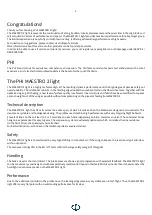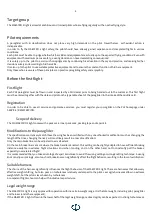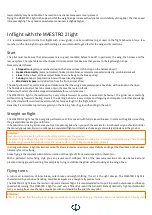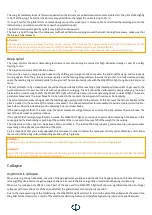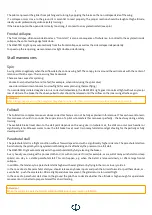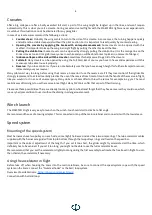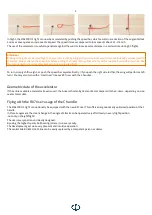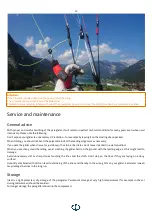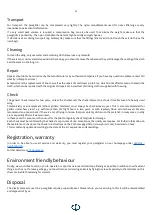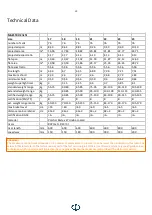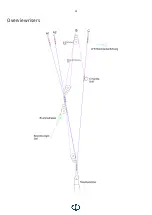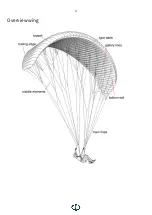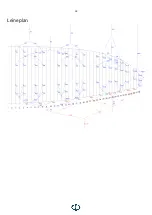
6
The wing immediately loses its forward speed when the B risers are pulled down and enters a stable stall. The pilot shi s slightly
in front of the wing. The further the B-risers are pulled down, the larger the sink rates (up to 9m / s).
If you pull too far, the glider starts to rotate slowly around its vertical axis. In this case, the hands should be raised again until the
rotation stops. (A rotation can also be caused by asymmetric pull).
The B-stall is recovered again by quickly moving the hands upwards.
The brake is held throughout the maneuver (without additional wrapping around the hand). During the recovery, make sure that
the brake is fully released.
Attention!
The big ears maneuver increases the drag on the canopy. This increases the angle of attack! In order to compensate for the
increase in the angle of attack and to avoid a stall, it is strongly recommended to use the accelerator.
When braking (pumping) to open the ears again (a er releasing the speed bar), care must be taken not to stall the wing.
Deep spiral
The deep spiral is the most demanding fast descent and should only be learned at high altitudes, ideally as part of a safety
training course.
The initiation can be divided into two phases:
First, you fly a turn by applying one brake and by shi ing your weight to the same side, the glider will bank up and increase its
turning speed. Then the g-forces increase rapidly and the leading edge will lean towards the ground. In a fully developed deep
spiral, the leading edge is almost parallel to the ground. The maximum sink rate with the MAESTRO 2 light can get up to 25m/s and
more.
The first attempts to fly a deep spiral should be stopped clearly before reaching a fully developed deep spiral to get used to the
quick rotation and to practice the exit without pendulum swinging. The exit should be performed by simply releasing the inner
brake with a neutral weight-shi . The MAESTRO 2 light will then decrease its bank angle and go back to normal flight. To avoid a
pendulum movement, the inner brake has to be pulled in the moment the wing wants to reduce its bank rapidly.
The actual spiral movement begins with the leading edge nearly parallel to the horizon. At this moment the harness banks and the
pilot is pushed to the outside of the rotation movement. The pilot should allow this movement to avoid a stable spiral situation.
(see below). Now the sink values can be varied by inner and outer brake.
If the pilot weight shi s to the outer side, the spiral movement will get slower as soon as the pilot releases the inner brake. The
rest of the exit works as explained above.
If the pilot shi s his weight significantly inwards, the MAESTRO 2 light can continue to spiral when releasing both brakes. In this
case apply both sides braking or braking of the outside of the curve and of course shi of the weight to the outside.
The sink values in the spiral can be between 10m/s and 20m/s. The load on the body is over 4g and can lead to unconsciousness
depending on the physical constitution of the pilot.
So it is important that you slowly approach this maneuver in order to master the maneuver actively and confidently, and to know
the reaction of the body in this demanding situation of high g-forces.
Attention!
Actively exiting a stable deep spiral requires an unusually large amount of body force due to the high g-load!
Attention!
Due to the high performance and dynamics of the wing you have to expect that the glider rises up some altitude a er the release
of the deep spiral and hits his own vortex turbulence!
Collapse
Asymmetric collapse
When entering strong turbulence, one side of the paraglider may collapse. Specifically, this happens when on this side of the wing
is losing li by decreased or negative angle of attack. As a result the lines are getting unloaded and the wing is collapsing.
When such a collapse only affects a small part of the span and the MAESTRO 2 light will show no significant reaction. For larger
collapses with more than 50% of the span affected, the glider shows a more dynamic reaction:
Due to the increased drag of the folded wing, the MAESTRO 2 light will start to turn to the side of the collapse. At the same time,
the glider pitches forward as a result of the smaller loaded wing surface and therefore higher wing load and needed airspeed.
Summary of Contents for MAESTRO 2 light
Page 1: ...1 Manual Version 1 02 vom 19 09 2022 ...
Page 12: ...12 PHI PHI eine Marke der Papesh GmbH Grillparzerstrasse 10 6067 ABSAM Österreich ...
Page 14: ...14 Overview risers ...
Page 15: ...15 R07 riser ...
Page 17: ...17 Overview wing ...
Page 18: ...18 Leineplan ...


